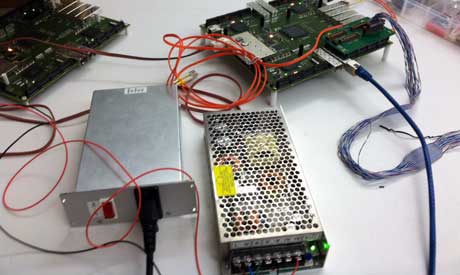Three of GW’s physics faculty, Evie Downie, William Briscoe and Andrei Afanasev, are leading the way in solving the “Proton Radius Puzzle,” along with more than 45 researchers from around the globe participating in the MUon proton Scattering Experiment (MUSE) Collaboration. GW was awarded a $277,000, 18-month grant in July 2014 from the Department of Energy (DOE) and the National Science Foundation (NSF). This has far reaching consequences for understanding the proton, as well as the atom—the basic building block of matter. While the implications of solving this scientific puzzle remain to be seen, fully understanding the proton’s radius measurement and behavior has practical applications like improvements to medical imaging, radiation therapy treatment, or new developments in cutting-edge technology (ex. smaller computer parts and quantum computing).
“This puzzle is scientifically significant as it challenges the long-accepted standard model of physics,” said Evie Downie, MUSE Collaboration co-spokesperson and assistant professor in the GW physics department. “As most of the plausible explanations and theories have now been eliminated, our research holds great potential for solving the puzzle and opening up new research areas.”
The puzzle emerged four years ago, when researchers attempting to measure more precisely the proton’s radius with a new technique got results showing it was much smaller than expected. Their 2010 Nature article baffled the scientific community. Many theories have surfaced to explain the error(s) or even challenge the fundamentals of what is known and accepted about physics to date. Since then the topic has been featured in popular science magazines, including Scientific American and New Scientist.
GW researchers are hard at work on the new grant, already designing and testing the electronics, the hydrogen target and related components at GW’s Virginia Science and Technology Campus (VSTC). They will then run the experiment in conjunction with their collaborators at the Paul Scherrer Institute (PSI) in Switzerland.
“We are working closely with researchers at PSI and other members of the MUSE collaboration to test almost all of the possible hypotheses for what is causing the discrepancy, “said William Briscoe, professor of physics. “In summary, we plan to precisely measure the proton radius by using muon scattering on the proton, while simultaneously measuring the electron scattering.”
“Muons are about two hundred times heavier than electrons,” adds Afanasev, “and they are known to interact with matter differently due to their larger mass. But the size of the proton seems different for these two particles and this puzzling fact cannot be explained by the Standard Model of interactions between elementary particles, the model that was celebrated by a recent discovery of Higgs Boson at Large Hadron Collider.”
More details about the experiment follow below:
Electronic Components (Downie):
Multiple detectors need to be built for the experiment by a core group of seven US & Israeli universities. In order to read out the energy deposits and times measured by the detector system and allow the researchers to reconstruct what is happening, the experiment requires a system using over 100 specially programmed Field Programmable Gate Array (FPGA) chips, other specialized electronics and around 25 computers.Hydrogen Target (Briscoe):
The experiment requires a target containing a high density of protons, like hydrogen. GW is building a cryogenic hydrogen target to prepare the hydrogen by increasing the density of protons in its gaseous state. This will be done by liquefying the hydrogen at about 18 Kelvin, using a very efficient refrigeration system and a vacuum vessel to isolate the target from the environment.Theoretical Calculations (Afanasev):
The experiment requires special theoretical calculations needed to interpret the data and “extract the proton radius.”
A total of $747,000 was collectively awarded to the MUSE Collaboration by DOE and NSF after an initial review this year, in order to fund research and design, detector prototyping and testing, electronic components and the hydrogen target.
Researchers anticipate that additional funding to fully validate the experiment’s results may be forthcoming. It is yet unknown just how significant the answers will be for the “standard model of physics” or practical applications like radiation therapy, but there is hope the collaboration’s collective brain power will soon be able to make sense of the puzzle pieces.


